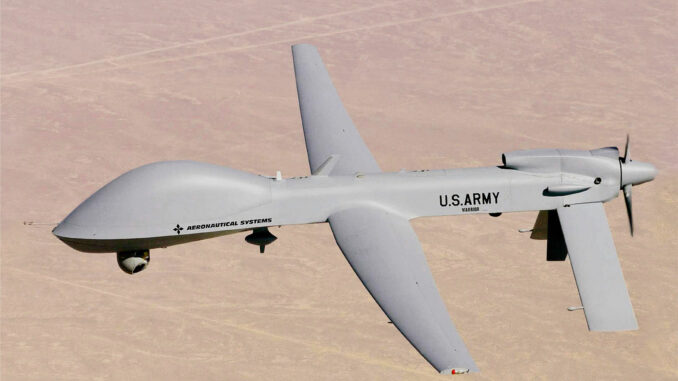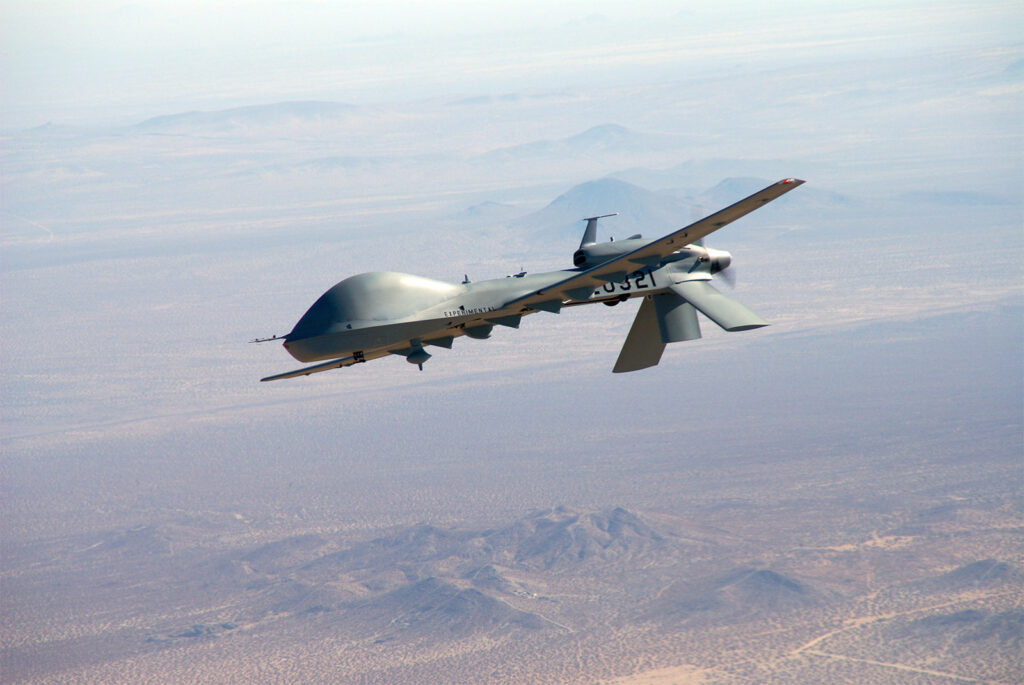
The MQ-1C Gray Eagle uses the AGM-114L Longbow Hellfire missile to shoot down drones in tests. Discover its C-UAS capabilities, advanced radars, and kinetic weapons.
The MQ-1C Gray Eagle, an unmanned aerial system (UAS) developed by General Atomics Aeronautical Systems (GA-ASI), has demonstrated its ability to neutralize drones in live-fire tests using the AGM-114L Longbow Hellfire missile, guided by millimeter-wave radar. The tests, conducted at Dugway Proving Ground, Utah, mark a breakthrough in counter-UAS (C-UAS) systems, combining kinetic solutions such as Hellfire missiles and Dillon Aero DAP-6 Minigun machine guns with non-kinetic options such as lasers currently in development. The Gray Eagle STOL (short takeoff and landing) enhances its operational flexibility, enabling missions from rough terrain. Lynx and EagleEye radars detect and track drones, with a ground range of 80 km and a maritime range of 200 km. These innovations respond to the growing threat of drones, particularly in regions such as the Middle East. However, the high cost of the Longbow Hellfire (approximately $200,000 per missile) is prompting GA-ASI to explore less expensive alternatives, such as laser-guided rockets.
MQ-1C Gray Eagle tests with Longbow Hellfire missile
The MQ-1C Gray Eagle, a medium-altitude, long-endurance (MALE) UAS, has been successfully tested to shoot down a small drone during live-fire tests at Dugway Proving Ground, Utah. These tests used the AGM-114L Longbow Hellfire missile, a millimeter-wave radar-guided projectile capable of operating in difficult weather conditions. According to GA-ASI spokesperson C. Mark Brinkley, this demonstration marks a new application for the Gray Eagle as a C-UAS platform. The missile, weighing 49 kg and with a range of 8 km, was coupled with the Gray Eagle’s onboard radar, likely the Lynx or EagleEye, to detect and neutralize the target.
This capability comes at a time when drones, particularly kamikaze drones, are proliferating. For example, in 2023, drone attacks in Ukraine increased by 30% according to defense reports, highlighting the urgency of C-UAS solutions. The Longbow Hellfire, originally designed for ground targets such as tanks, offers increased accuracy thanks to its radar guidance, unlike laser-guided variants. However, its cost, estimated at €200,000 per unit, limits its use to strategic targets. Tests confirm that the Gray Eagle can redefine air defense strategies, but raise questions about the balance between effectiveness and cost.

Development of alternative kinetic options
GA-ASI is exploring kinetic alternatives to reduce the cost of C-UAS missions. During tests in 2024 at Yuma Proving Ground, the Mojave demonstrator validated the use of Dillon Aero DAP-6 Minigun machine guns firing 7.62 mm ammunition. These pod-mounted weapons offer an affordable solution against small drones, often referred to as “flying trash cans” due to their low resistance. A DAP-6 machine gun can fire 3,000 rounds per minute, with a cost per round of approximately €0.50, well below that of a Hellfire missile.
Brinkley said that a new kinetic option, potentially a laser-guided rocket such as the APKWS II, will be introduced in the coming months for the Gray Eagle STOL. The APKWS II, costing $25,000 per unit, would increase engagement capability with a larger magazine. For example, a Gray Eagle could carry 12 APKWS II rockets compared to only four Hellfires, increasing its tactical flexibility. This approach is inspired by the recent use of the APKWS II by F-16s against drones in the Red Sea, demonstrating its effectiveness against slow-moving targets.
Gray Eagle STOL capabilities for C-UAS operations
The Gray Eagle STOL, derived from the Mojave demonstrator, is designed to operate from rough runways, with a takeoff distance of 122 m for intelligence missions and 305 m with 12 Hellfire missiles. This capability, tested in 2023 near El Mirage, California, meets the needs of decentralized operations, particularly in the Pacific where forward bases are scarce. The STOL incorporates improvements from the Gray Eagle 25M, including increased resilience to electronic jamming via visual navigation and anti-jamming SATCOM technologies.
In 2024, trials on the HMS Prince of Wales aircraft carrier demonstrated the STOL’s ability to operate without catapults or arresting wires, reinforcing its value for maritime defense against drones. With a 24-hour endurance and a maximum altitude of 8,800 m, the Gray Eagle STOL can maintain extended air patrols, ideal for monitoring high-risk areas such as the Middle East, where kamikaze drones have been used in 60% of recent air attacks according to CENTCOM data.
Lynx and EagleEye radars for drone detection
The Lynx and EagleEye radars, developed by GA-ASI, play a key role in detecting and tracking drones. The EagleEye, a synthetic aperture radar, can spot ground targets at 80 km and maritime targets at 200 km. Although its performance against air targets is not fully documented, tests have validated its air-to-air mode, including downward vision, which is essential for detecting low-altitude drones. A new active electronically scanned array (AESA) antenna currently under development will increase its range and versatility.
In comparison, the AN/APG-78 Longbow radar on AH-64 Apache helicopters detects air targets at 10 km, illustrating the EagleEye’s advantage for long-range missions. These capabilities allow the Gray Eagle to act as a multi-role platform, combining detection, tracking, and engagement. For example, during exercises in the Middle East in 2024, Apaches used Longbow Hellfire missiles to shoot down drones, a tactic that the Gray Eagle can replicate with superior range and endurance.
Development of a C-UAS laser for the Gray Eagle
GA-ASI is working on a podded laser for the MQ-9B SkyGuardian, adaptable to the Gray Eagle, which will be unveiled in 2025 at symposiums in the United States. This laser, intended for fleet defense against unidirectional attack drones, promises a cost-effective solution with a negligible cost per shot compared to the $200,000 cost of a Hellfire. However, airborne lasers remain complex, as demonstrated by the cancellation of programs such as the YAL-1 Airborne Laser in 2011 for technical reasons.
Current tests are focusing on the maturity of GA-ASI’s laser technology, which could neutralize multiple drones without reloading, unlike missiles. For example, a 50 kW laser, such as those tested by Lockheed Martin, can destroy a drone in 2 seconds at a distance of 1 km. If integrated into the Gray Eagle, this laser would enhance its ability to protect forward bases or ships, but its development could take 3 to 5 years according to market estimates.
Consequences of the Gray Eagle C-UAS tests
The Gray Eagle trials with the Longbow Hellfire are redefining C-UAS approaches. Unlike ground-based systems, which are limited in range and mobility, the Gray Eagle offers unique flexibility. Its ability to be deployed quickly near ground forces, with a 24-hour endurance, makes it an ideal platform for defensive air patrols. In Ukraine, where drones account for 40% of material losses according to 2024 reports, such a system could protect critical infrastructure.
However, the cost of the Longbow Hellfire poses an economic challenge. With a price tag of €200,000, its use against drones costing €1,000 is difficult to justify. This is prompting GA-ASI to favor solutions such as the APKWS II or lasers. In addition, the integration of advanced radars and versatile weapons makes the Gray Eagle a multi-role platform capable of supporting intelligence and armed escort missions, reducing dependence on expensive fighters such as the F-16, whose hourly cost exceeds €25,000.

Outlook for the C-UAS market
The global market for C-UAS systems is expected to reach €5.2 billion by 2030, with an annual growth rate of 26% according to MarketsandMarkets. Gray Eagle drones, with their multi-role capabilities, could capture a significant share of this market, particularly for armies seeking mobile solutions. Countries such as Poland and Australia, already interested in GA-ASI drones, could adopt the Gray Eagle to counter threats from Russian or Chinese drones.
However, competition is fierce, with systems such as Raytheon’s Coyote (unit cost: €50,000) and Rheinmetall’s ground-based lasers. The Gray Eagle will need to demonstrate cost-effectiveness, particularly through weapons such as the APKWS II or the laser pod, in order to remain competitive. Ongoing tests and future deployments, particularly in conflict zones such as the Middle East, will be crucial in validating its role in modern defense.
War Wings Daily is an independant magazine.